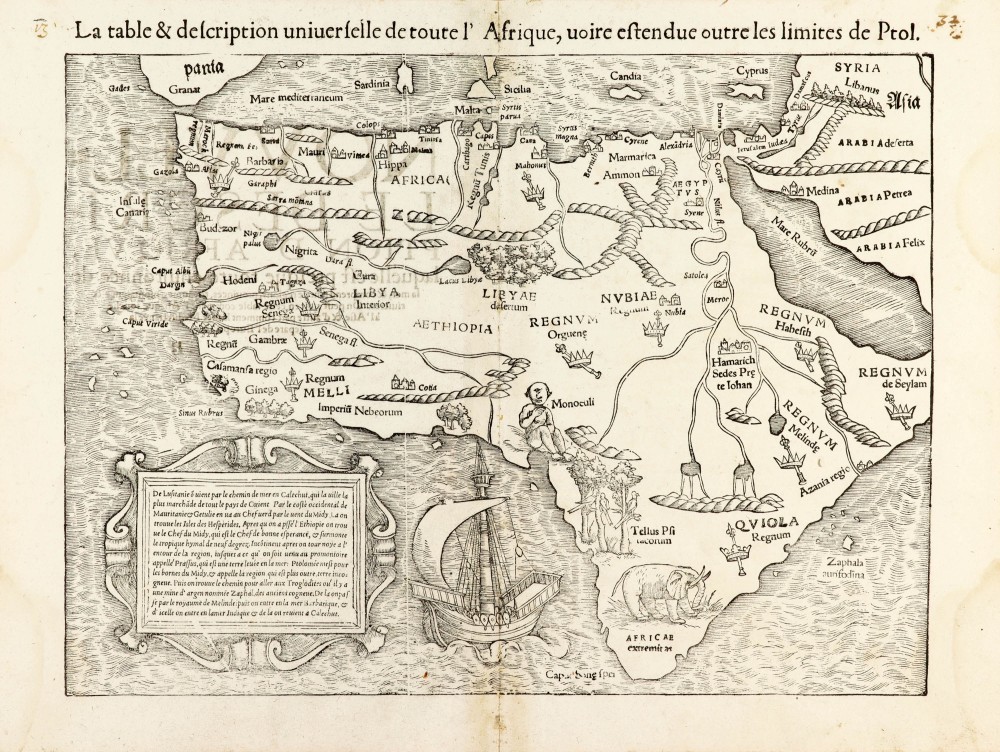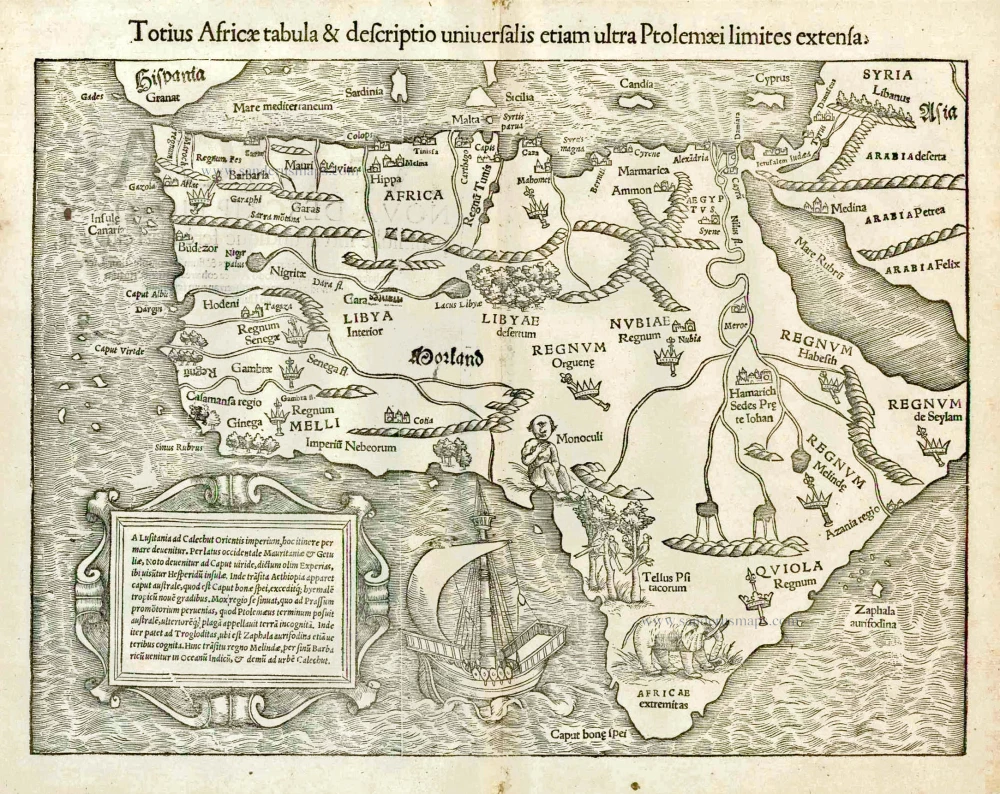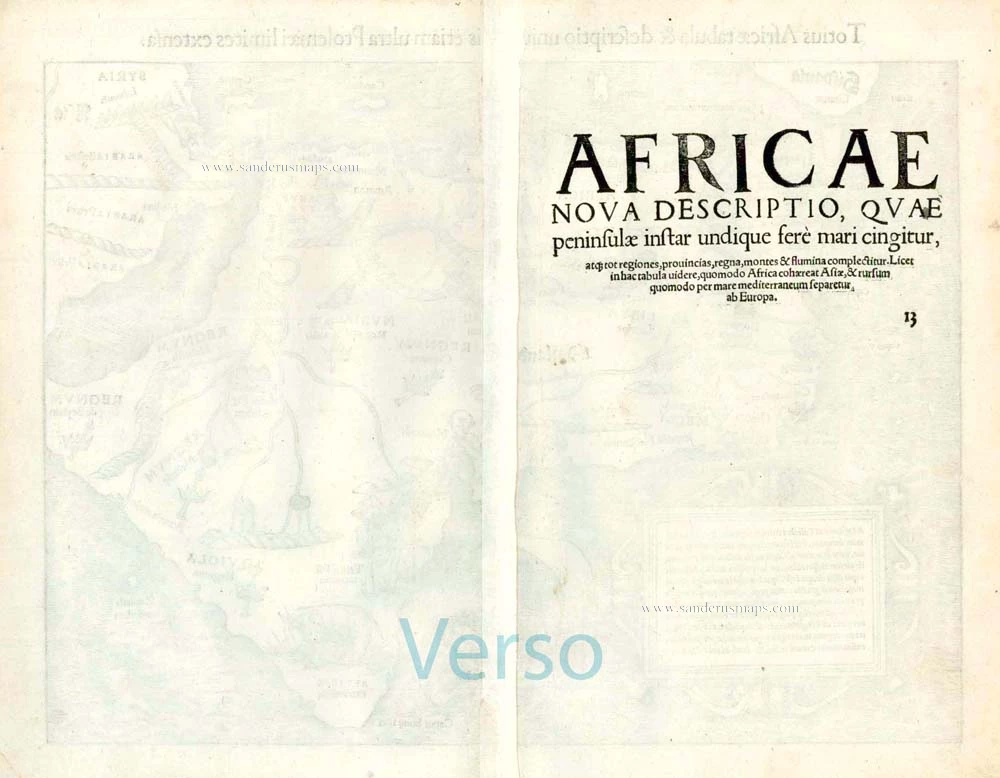Old, antique map of Africa by S. Münster. 1552
This is the earliest printed map showing the entire continent of Africa. It is famous for the medieval depiction of the Cyclopes, the Monoculi on the map, the parrots and an elephant in Southern Africa. Crowns and sceptres identify various African kingdoms throughout the continent, including Hamarich, the capital of the famous fictional Christian King, Prester John.
The lower left of the map has a cartouche that describes the Europeans' discovery of Africa and their movement down the West African coast to the Cape of Good Hope, around the Cape, up the East African coast, and across to Calicut in India in search of spices.
Münster produced sixty-one double-page maps for use in various editions of Ptolemy's Geographia and in his own Cosmographia. Some of these maps appeared in all editions of both works, some only in certain editions. All were woodcut maps with the title supplied in letter-press in the upper margin; these titles varied from edition to edition.
Sebastian Münster (1488-1552)
Sebastian Münster, a German geographer, cartographer, Hebraist, and theologian, was born in Ingelheim, near Mainz In 1505, he went to Heidelberg to enter the Franciscan order. In 1507 he went to Louvain, where he studied mathematics, geography, and astronomy. In 1509 Münster became a student of Konrad Pelikan, who taught Hebrew and Greek as well as mathematics and cosmography. In 1518 he completed his studies at the University of Tübingen. He was the favorite of the famous mathematician and astronomer Johann Stöffler.
In 1524 Münster was appointed professor of Hebrew at Heidelberg University. In 1525 he published his first map as part of a broadside: The Instrument of the Suns combined a map, calendar, astrological almanac, sundial, and nocturnal on one attractive sheet, suitable for wall mounting.
In 1540 he published a Latin edition of Ptolemy's Geographia with illustrations. He based this edition on the Latin translation by Willibald Pirkheimer and produced new maps to supplement the Ptolemaic maps. The twenty-seven maps of the Ptolemaic canon are supplemented by twenty-one new maps. Further editions appeared in 1541 and 1542.
In 1544 he published the Cosmographia, a bulky book with 659 pages and some 520 woodcuts. Maps in this edition included three maps from the Ptolemaic canon and fourteen modern maps (from previous editions of the Geographia), as well as nine new maps. Later editions (1545, 1546, 1548) enlarged the Cosmographia. The 1550 edition contains cities, portraits, and costumes. These editions in both Latin and German constitute the full fruition of Münster's dream of a comprehensive geography.
The Cosmographia was one of the most successful works of the 16th century. It passed through 24 editions in 100 years, in different languages, including Latin, French, Italian, English, and even Czech. The last German edition was published in 1628.
He died at Basel of the plague in 1552.
As a cartographer, Münster deserves special recognition for formulating a plan for a comprehensive and uniform map of a country. As a geographer, his greatest achievement was the Cosmographia. (Karrow).
Totius Africae tabula, & descriptio universalis, etiam ultra Ptolemaei limites extensa.
Item Number: 25726 Authenticity Guarantee
Category: Antique maps > Africa
Africa by Sebastian Münster.
Title: Totius Africae tabula, & descriptio universalis, etiam ultra Ptolemaei limites extensa.
Date of the first edition: 1540.
Date of this map: 1552.
Woodcut, printed on paper.
Size (not including margins): 260 x 340mm (10.24 x 13.39 inches).
Verso: Latin text.
Condition: Excellent.
Condition Rating: A+.
From: Münster S. Cosmographiae Universalis Lib. VI. . . . Basle, H. Petri, 1552.
This is the earliest printed map showing the entire continent of Africa. It is famous for the medieval depiction of the Cyclopes, the Monoculi on the map, the parrots and an elephant in Southern Africa. Crowns and sceptres identify various African kingdoms throughout the continent, including Hamarich, the capital of the famous fictional Christian King, Prester John.
The lower left of the map has a cartouche that describes the Europeans' discovery of Africa and their movement down the West African coast to the Cape of Good Hope, around the Cape, up the East African coast, and across to Calicut in India in search of spices.
Münster produced sixty-one double-page maps for use in various editions of Ptolemy's Geographia and in his own Cosmographia. Some of these maps appeared in all editions of both works, some only in certain editions. All were woodcut maps with the title supplied in letter-press in the upper margin; these titles varied from edition to edition.
Sebastian Münster (1488-1552)
Sebastian Münster, a German geographer, cartographer, Hebraist, and theologian, was born in Ingelheim, near Mainz In 1505, he went to Heidelberg to enter the Franciscan order. In 1507 he went to Louvain, where he studied mathematics, geography, and astronomy. In 1509 Münster became a student of Konrad Pelikan, who taught Hebrew and Greek as well as mathematics and cosmography. In 1518 he completed his studies at the University of Tübingen. He was the favorite of the famous mathematician and astronomer Johann Stöffler.
In 1524 Münster was appointed professor of Hebrew at Heidelberg University. In 1525 he published his first map as part of a broadside: The Instrument of the Suns combined a map, calendar, astrological almanac, sundial, and nocturnal on one attractive sheet, suitable for wall mounting.
In 1540 he published a Latin edition of Ptolemy's Geographia with illustrations. He based this edition on the Latin translation by Willibald Pirkheimer and produced new maps to supplement the Ptolemaic maps. The twenty-seven maps of the Ptolemaic canon are supplemented by twenty-one new maps. Further editions appeared in 1541 and 1542.
In 1544 he published the Cosmographia, a bulky book with 659 pages and some 520 woodcuts. Maps in this edition included three maps from the Ptolemaic canon and fourteen modern maps (from previous editions of the Geographia), as well as nine new maps. Later editions (1545, 1546, 1548) enlarged the Cosmographia. The 1550 edition contains cities, portraits, and costumes. These editions in both Latin and German constitute the full fruition of Münster's dream of a comprehensive geography.
The Cosmographia was one of the most successful works of the 16th century. It passed through 24 editions in 100 years, in different languages, including Latin, French, Italian, English, and even Czech. The last German edition was published in 1628.
He died at Basel of the plague in 1552.
As a cartographer, Münster deserves special recognition for formulating a plan for a comprehensive and uniform map of a country. As a geographer, his greatest achievement was the Cosmographia. (Karrow).





